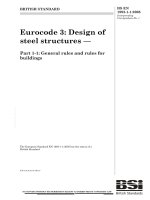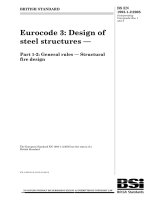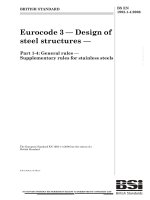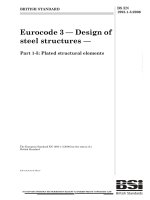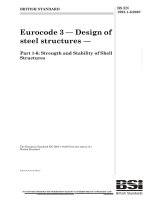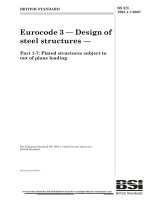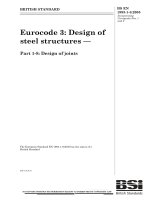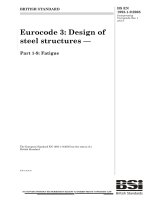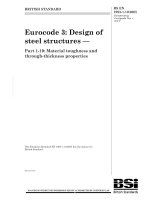Tiêu chuẩn Châu Âu EC3: Kết cấu thép phần 1.3: Quy định chung, thép cán nguội (Eurocode3 BS EN1993 1 3 e 2006 Design of steel structures part 1.3: Supplement rules for coldformed member and sheeting(
Bạn đang xem bản rút gọn của tài liệu. Xem và tải ngay bản đầy đủ của tài liệu tại đây (2.85 MB, 134 trang )
BRITISH STANDARD
Eurocode 3 — Design of
steel structures —
Part 1-3: General rules —
Supplementary rules for cold-formed
members and sheeting
The European Standard EN 1993-1-3:2006 has the status of a
British Standard
ICS 91.010.30
--```,,`,`````,,`,,``,`,,,,,`,,-`-`,,`,,`,`,,`---
12 &23<,1* :,7+287 %6, 3(50,66,21 (;&(37 $6 3(50,77(' %< &23<5,*+7 /$:
BS EN
1993-1-3:2006
BS EN 1993-1-3:2006
National foreword
This British Standard was published by BSI. It is the UK implementation of
EN 1993-1-3:2006. It supersedes DD ENV 1993-1-3:2001 which is withdrawn.
It partially supersedes BS 5950-5:1998, BS 5950-6:1995 and BS 5950-9:1994.
These standards will be withdrawn by March 2010 at the latest.
The UK participation in its preparation was entrusted by Technical Committee
B/525, Building and civil engineering structures, to Subcommittee B/525/31,
Structural use of steel.
A list of organizations represented on B/525/31 can be obtained on request to
its secretary.
The structural Eurocodes are divided into packages by grouping Eurocodes for
each of the main materials: concrete, steel, composite concrete and steel,
timber, masonry and aluminium; this is to enable a common date of
withdrawal (DOW) for all the relevant parts that are needed for a particular
design. The conflicting national standards will be withdrawn at the end of the
coexistence period, after all the EN Eurocodes of a package are available.
Following publication of the EN, there is a period allowed for national
calibration during which the National Annex is issued, followed by a
coexistence period of a maximum three years. During the coexistence period
Member States are encouraged to adapt their national provisions. Conflicting
national standards will be withdrawn by March 2010 at the latest. Where a
normative part of this EN allows for a choice to be made at national level, the
range and possible choice will be given in the normative text, and a note will
qualify it as a Nationally Determined Parameter (NDP). NDPs can be a specific
value for a factor, a specific level or class, a particular method or a particular
application rule if several are proposed in the EN. To enable EN 1993-1-3 to be
used in the UK, the NDPs will be published in a National Annex, which will be
made available by BSI in due course after public consultation has taken place.
This publication does not purport to include all the necessary provisions of a
contract. Users are responsible for its correct application.
This British Standard was
published under the authority
of the Standards Policy and
Strategy Committee
on 30 November 2006
© BSI 2006
ISBN 0 580 49665 1
Amendments issued since publication
Amd. No.
Date
Comments
--```,,`,`````,,`,,``,`,,,,,`,,-`-`,,`,,`,`,,`---
Compliance with a British Standard cannot confer immunity from
legal obligations.
EUROPEAN STANDARD
EN 1993-1-3
NORME EUROPÉENNE
EUROPÄISCHE NORM
October 2006
ICS 91.010.30
Supersedes ENV 1993-1-3:1996
English Version
Eurocode 3 - Design of steel structures - Part 1-3: General rules
- Supplementary rules for cold-formed members and sheeting
Eurocode 3 - Calcul des structures en acier - Partie 1-3:
Règles générales - Règles supplémentarires pour les
profilés et plaques à parois minces formés à froid
Eurocode 3 - Bemessung und Konstruktion von
Stahlbauten - Teil 1-3: Allgemeine Regeln - Ergänzende
Regeln für kaltgeformte dünnwandige Bauteile und Bleche
This European Standard was approved by CEN on 16 January 2006.
CEN members are bound to comply with the CEN/CENELEC Internal Regulations which stipulate the conditions for giving this European
Standard the status of a national standard without any alteration. Up-to-date lists and bibliographical references concerning such national
standards may be obtained on application to the Central Secretariat or to any CEN member.
This European Standard exists in three official versions (English, French, German). A version in any other language made by translation
under the responsibility of a CEN member into its own language and notified to the Central Secretariat has the same status as the official
versions.
CEN members are the national standards bodies of Austria, Belgium, Cyprus, Czech Republic, Denmark, Estonia, Finland, France,
Germany, Greece, Hungary, Iceland, Ireland, Italy, Latvia, Lithuania, Luxembourg, Malta, Netherlands, Norway, Poland, Portugal, Romania,
Slovakia, Slovenia, Spain, Sweden, Switzerland and United Kingdom.
EUROPEAN COMMITTEE FOR STANDARDIZATION
COMITÉ EUROPÉEN DE NORMALISATION
EUROPÄISCHES KOMITEE FÜR NORMUNG
Management Centre: rue de Stassart, 36
© 2006 CEN
B-1050 Brussels
All rights of exploitation in any form and by any means reserved
worldwide for CEN national Members.
--```,,`,`````,,`,,``,`,,,,,`,,-`-`,,`,,`,`,,`---
Ref. No. EN 1993-1-3:2006: E
EN 1993-1-3: 2006 (E)
Content
1
2
Introduction
5
1.1
1.2
1.3
1.4
1.5
5
5
6
7
8
Scope
Normative references
Terms and definitions
Symbols
Terminology and conventions for dimensions
Basis of design
11
3 Materials
12
3.1 General
3.2 Structural steel
3.3 Connecting devices
12
15
17
4 Durability
17
5 Structural analysis
18
5.1
5.2
5.3
5.4
5.5
5.6
Influence of rounded corners
Geometrical proportions
Structural modelling for analysis
Flange curling
Local and distortional buckling
Plate buckling between fasteners
6 Ultimate limit states
7
8
9
18
20
22
22
23
41
41
6.1 Resistance of cross-sections
6.2 Buckling resistance
6.3 Bending and axial tension
41
56
60
Serviceability limit states
60
7.1 General
7.2 Plastic deformation
7.3 Deflections
60
60
60
Design of joints
61
8.1
8.2
8.3
8.4
8.5
61
61
61
68
69
General
Splices and end connections of members subject to compression
Connections with mechanical fasteners
Spot welds
Lap welds
Design assisted by testing
73
10 Special considerations for purlins, liner trays and sheetings
74
10.1 Beams restrained by sheeting
10.2 Liner trays restrained by sheeting
10.3 Stressed skin design
10.4 Perforated sheeting
74
92
95
99
Annex A [normative] – Testing procedures
100
A.1
A.2
A.3
A.4
A.5
A.6
2
General
Tests on profiled sheets and liner trays
Tests on cold-formed members
Tests on structures and portions of structures
Tests on torsionally restrained beams
Evaluation of test results
--```,,`,`````,,`,,``,`,,,,,`,,-`-`,,`,,`,`,,`---
100
100
105
108
110
114
EN 1993-1-3: 2006 (E)
Annex B [informative] – Durability of fasteners
119
Annex C [informative] – Cross section constants for thin-walled cross sections
121
C.1 Open cross sections
C.2 Cross section constants for open cross section with branches
C.3 Torsion constant and shear centre of cross section with closed part
121
123
124
Annex D [informative] – Mixed effective width/effective thickness method for outstand elements
125
Annex E [Informative] – Simplified design for purlins
127
--```,,`,`````,,`,,``,`,,,,,`,,-`-`,,`,,`,`,,`---
3
EN 1993-1-3: 2006 (E)
Foreword
This European Standard EN 1993-1-3, Eurocode 3: Design of steel structures: Part 1-3 General rules –
Supplementary rules for cold formed members and sheeting, has been prepared by Technical Committee
CEN/TC250 « Structural Eurocodes », the Secretariat of which is held by BSI. CEN/TC250 is responsible for
all Structural Eurocodes.
This European Standard shall be given the status of a National Standard, either by publication of an identical
text or by endorsement, at the latest by April 2007, and conflicting National Standards shall be withdrawn at
latest by March 2010.
This Eurocode supersedes ENV 1993-1-3.
According to the CEN-CENELEC Internal Regulations, the National Standard Organizations of the following
countries are bound to implement this European Standard: Austria, Belgium, Cyprus, Czech Republic,
Denmark, Estonia, Finland, France, Germany, Greece, Hungary, Iceland, Ireland, Italy, Latvia, Lithuania,
Luxembourg, Malta, Netherlands, Norway, Poland, Portugal, Romania, Slovakia, Slovenia, Spain, Sweden,
Switzerland and United Kingdom.
National annex for EN 1993-1-3
This standard gives alternative procedures, values and recommendations for classes with notes indicating
where national choices may have to be made. Therefore the National Standard implementing EN 1993-1-3
should have a National Annex containing all Nationally Determined Parameters to be used for the design of
steel structures to be constructed in the relevant country.
National choice is allowed in EN 1993-1-3 through clauses:
–
2(3)P
–
2(5)
–
3.1(3) Note 1 and Note 2
–
3.2.4(1)
–
5.3(4)
–
8.3(5)
–
8.3(13), Table 8.1
–
8.3(13), Table 8.2
–
8.3(13), Table 8.3
–
8.3(13), Table 8.4
–
8.4(5)
–
8.5.1(4)
–
9(2)
–
10.1.1(1)
–
10.1.4.2(1)
–
A.1(1), NOTE 2
–
A.1(1), NOTE 3
–
A.6.4(4)
–
E(1)
--```,,`,`````,,`,,``,`,,,,,`,,-`-`,,`,,`,`,,`---
4
EN 1993-1-3: 2006 (E)
1
Introduction
1.1 Scope
(1) EN 1993-1-3 gives design requirements for cold-formed thin gauge members and sheeting. It applies to
cold-formed steel products made from coated or uncoated thin gauge hot or cold rolled sheet or strip, that have
been cold-formed by such processes as cold-rolled forming or press-braking. It may also be used for the design
of profiled steel sheeting for composite steel and concrete slabs at the construction stage, see EN 1994. The
execution of steel structures made of cold-formed thin gauge members and sheeting is covered in EN 1090.
NOTE: The rules in this part complement the rules in other parts of EN 1993-1.
(2) Methods are also given for stressed-skin design using steel sheeting as a structural diaphragm.
(3) This part does not apply to cold-formed circular and rectangular structural hollow sections supplied to EN
10219, for which reference should be made to EN 1993-1-1 and EN 1993-1-8.
(4) EN 1993-1-3 gives methods for design by calculation and for design assisted by testing. The methods for
design by calculation apply only within stated ranges of material properties and geometrical proportions for
which sufficient experience and test evidence is available. These limitations do not apply to design assisted by
testing.
(5) EN 1993-1-3 does not cover load arrangement for testing for loads during execution and maintenance.
(6) The calculation rules given in this standard are only valid if the tolerances of the cold formed members
comply with EN 1090-2
The following normative documents contain provisions which, through reference in this text, constitute
provisions of this European Standard. For dated references, subsequent amendments to, or revisions of, any of
these publications do not apply.
However, parties to agreements based on this European Standard are encouraged to investigate the possibility
of applying the most recent editions of the normative documents indicated below. For undated references, the
latest edition of the normative document referred to applies.
EN 1993
Eurocode 3 – Design of steel structures
Part 1-1 to part 1-12
EN 10002
Part 1:
Metallic materials - Tensile testing:
Method of test (at ambient temperature);
EN 10025-1
Hot-rolled products of structural steels - Part 1: General delivery conditions;
EN 10025-2
Hot-rolled products of structural steels - Part 2: Technical delivery conditions for non-alloy
structural steels;
EN 10025-3
Hot-rolled products of structural steels - Part 3: Technical delivery conditions for normalized
/ normalized rolled weldable fine grain structural steels;
EN 10025-4
Hot-rolled products of structural steels - Part 4: Technical delivery conditions for
thermomechanical rolled weldable fine grain structural steels;
EN 10025-5
Hot-rolled products of structural steels - Part 5: Technical delivery conditions for structural
steels with improved atmospheric corrosion resistance;
EN 10143
Continuously hot-dip metal coated steel sheet and strip - Tolerances on dimensions and shape;
EN 10149
Hot rolled flat products made of high yield strength steels for cold-forming:
Part 2:
Delivery conditions for normalized/normalized rolled steels;
Part 3:
Delivery conditions for thermomechanical rolled steels;
EN 10204
Metallic products. Types of inspection documents (includes amendment A 1:1995);
EN 10268
Cold-rolled flat products made of high yield strength micro-alloyed steels for cold forming General delivery conditions;
5
--```,,`,`````,,`,,``,`,,,,,`,,-`-`,,`,,`,`,,`---
1.2 Normative references
EN 1993-1-3: 2006 (E)
EN 10292
Continuously hot-dip coated strip and sheet of steels with higher yield strength for cold
forming - Technical delivery conditions;
EN 10326
Continuously hot-dip coated strip and sheet of structural steels - Technical delivery conditions;
EN 10327
Continuously hot-dip coated strip and sheet of low carbon steels for cold forming - Technical
delivery conditions;
EN-ISO 12944-2
Paints and vanishes. Corrosion protection of steel structures by protective paint systems.
Part 2: Classification of environments (ISO 12944-2:1998);
EN 1090-2
Execution of steel structures and aluminium structures
Part 2: Technical requirements for steel structures:
EN 1994
Eurocode 4: Design of composite steel and concrete structures;
EN ISO 1478 Tapping screws thread;
EN ISO 1479 Hexagon head tapping screws;
EN ISO 2702 Heat-treated steel tapping screws - Mechanical properties;
EN ISO 7049 Cross recessed pan head tapping screws;
EN ISO 10684 Fasteners – hot deep galvanized coatings
ISO 4997
Cold reduced steel sheet of structural quality;
EN 508-1
Roofing products from metal sheet - Specification for self-supporting products of steel,
aluminium or stainless steel sheet - Part 1: Steel;
FEM 10.2.02
Federation Europeenne de la manutention, Secion X, Equipment et proceedes de stockage,
FEM 10.2.02, The design of static steel pallet racking, Racking design code, April 2001
Version 1.02.
1.3 Terms and definitions
Supplementary to EN 1993-1-1, for the purposes of this Part 1-3 of EN 1993, the following terms and
definitions apply:
--```,,`,`````,,`,,``,`,,,,,`,,-`-`,,`,,`,`,,`---
1.3.1
basic material
The flat sheet steel material out of which cold-formed sections and profiled sheets are made by cold-forming.
1.3.2
basic yield strength
The tensile yield strength of the basic material.
1.3.3
diaphragm action
Structural behaviour involving in-plane shear in the sheeting.
1.3.4
liner tray
Profiled sheet with large lipped edge stiffeners, suitable for interlocking with adjacent liner trays to form a
plane of ribbed sheeting that is capable of supporting a parallel plane of profiled sheeting spanning
perpendicular to the span of the liner trays.
1.3.5
partial restraint
Restriction of the lateral or rotational movement, or the torsional or warping deformation, of a member or
element, that increases its buckling resistance in a similar way to a spring support, but to a lesser extent than a
rigid support.
6
EN 1993-1-3: 2006 (E)
1.3.6
relative slenderness
A normalized non-dimensional slenderness ratio.
1.3.7
restraint
Restriction of the lateral or rotational movement, or the torsional or warping deformation, of a member or
element, that increases its buckling resistance to the same extent as a rigid support.
1.3.8
stressed-skin design
A design method that allows for the contribution made by diaphragm action in the sheeting to the stiffness and
strength of a structure.
1.3.9
support
A location at which a member is able to transfer forces or moments to a foundation, or to another member or
other structural component.
1.3.10
nominal thickness
A target average thickness inclusive zinc and other metallic coating layers when present rolled and defined by
the steel supplier (tnom not including organic coatings).
1.3.11
steel core thickness
A nominal thickness minus zinc and other metallic coating layers (tcor).
1.3.12
design thickness
the steel core thickness used in design by calculation according to 1.5.3(6) and 3.2.4.
1.4 Symbols
(1) In addition to those given in EN 1993-1-1, the following main symbols are used:
--```,,`,`````,,`,,``,`,,,,,`,,-`-`,,`,,`,`,,`---
fy
yield strength
fya
average yield strength
fyb
basic yield strength
t
design core thickness of steel material before cold forming, exclusive of metal and organic coating
tnom
nominal sheet thickness after cold forming inclusive of zinc and other metallic coating not including
organic coating
tcor
the nominal thickness minus zinc and other metallic coating
K
spring stiffness for displacement
C
spring stiffness for rotation
(2)
Additional symbols are defined where they first occur.
(3)
A symbol may have several meanings in this part.
7
EN 1993-1-3: 2006 (E)
1.5 Terminology and conventions for dimensions
1.5.1 Form of sections
(1) Cold-formed members and profiled sheets have within the permitted tolerances a constant nominal
thickness over their entire length and may have either a uniform cross section or a tapering cross section along
their length.
(2) The cross-sections of cold-formed members and profiled sheets essentially comprise a number of plane
elements joined by curved elements.
(3) Typical forms of sections for cold-formed members are shown in figure 1.1.
a) Single open sections
b) Open built-up sections
c) Closed built-up sections
Figure 1.1: Typical forms of sections for cold-formed members
(4) Examples of cross-sections for cold-formed members and sheets are illustrated in figure 1.2.
NOTE: All rules in this Part 1-3 of EN 1993 relate to the main axis properties, which are defined by the main axes y - y
and z - z for symmetrical sections and u - u and v - v for unsymmetrical sections as e.g. angles and Zed-sections. In some
cases the bending axis is imposed by connected structural elements whether the cross-section is symmetric or not.
8
--```,,`,`````,,`,,``,`,,,,,`,,-`-`,,`,,`,`,,`---
NOTE: The calculation methods of this Part 1-3 of EN 1993 does not cover all the cases shown in figures 1.1-1.2.
--```,,`,`````,,`,,``,`,,,,,`,,-`-`,,`,,`,`,,`---
EN 1993-1-3: 2006 (E)
a) Compression members and tension members
b) Beams and other members subject to bending
c) Profiled sheets and liner trays
Figure 1.2: Examples of cold-formed members and profiled sheets
(5) Cross-sections of cold-formed members and sheets may either be unstiffened or incorporate longitudinal
stiffeners in their webs or flanges, or in both.
1.5.2 Form of stiffeners
(1) Typical forms of stiffeners for cold-formed members and sheets are shown in figure 1.3.
9
EN 1993-1-3: 2006 (E)
a) Folds and bends
b) Folded groove and curved groove
c) Bolted angle stiffener
Figure 1.3: Typical forms of stiffeners for cold-formed members and sheeting
(2) Longitudinal flange stiffeners may be either edge stiffeners or intermediate stiffeners.
(3) Typical edge stiffeners are shown in figure 1.4.
--```,,`,`````,,`,,``,`,,,,,`,,-`-`,,`,,`,`,,`---
a) Single edge fold stiffeners
b) Double edge fold stiffeners
Figure 1.4: Typical edge stiffeners
(4) Typical intermediate longitudinal stiffeners are illustrated in figure 1.5.
a) Intermediate flange stiffeners
b) Intermediate web stiffeners
Figure 1.5: Typical intermediate longitudinal stiffeners
1.5.3 Cross-section dimensions
(1) Overall dimensions of cold-formed members and sheeting, including overall width b, overall height h,
internal bend radius r and other external dimensions denoted by symbols without subscripts, such as a, c or d,
are measured to the face of the material, unless stated otherwise, as illustrated in figure 1.6.
10
EN 1993-1-3: 2006 (E)
b
c
--```,,`,`````,,`,,``,`,,,,,`,,-`-`,,`,,`,`,,`---
r
h
Figure 1.6: Dimensions of typical cross-section
(2) Unless stated otherwise, the other cross-sectional dimensions of cold-formed members and sheeting,
denoted by symbols with subscripts, such as bd, hw or sw, are measured either to the midline of the material or
the midpoint of the corner.
(3) In the case of sloping elements, such as webs of trapezoidal profiled sheets, the slant height s is measured
parallel to the slope. The slope is straight line between intersection points of flanges and web.
(4) The developed height of a web is measured along its midline, including any web stiffeners.
(5) The developed width of a flange is measured along its midline, including any intermediate stiffeners.
(6) The thickness t is a steel design thickness (the steel core thickness extracted minus tolerance if needed as
specified in clause 3.2.4), if not otherwise stated.
1.5.4 Convention for member axes
(1) In general the conventions for members is as used in Part 1-1 of EN 1993, see Figure 1.7.
v
z
u
v
y
u
z
z
z
u
v
y
y
v
u
u
y
z
v
y
u
y
z
v
Figure 1.7: Axis convention
(2) For profiled sheets and liner trays the following axis convention is used:
- y - y axis parallel to the plane of sheeting;
- z - z axis perpendicular to the plane of sheeting.
2
Basis of design
(1) The design of cold formed members and sheeting should be in accordance with the general rules given in
EN 1990 and EN 1993-1-1. For a general approach with FE-methods (or others) see EN 1993-1-5, Annex C.
(2)P Appropriate partial factors shall be adopted for ultimate limit states and serviceability limit states.
11
EN 1993-1-3: 2006 (E)
(3)P For verifications by calculation at ultimate limit states the partial factor γM shall be taken as follows:
- resistance of cross-sections to excessive yielding including local and distortional buckling: γM0
- resistance of members and sheeting where failure is caused by global buckling: γM1
- resistance of net sections at fastener holes: γM2
NOTE: Numerical values for γMi may be defined in the National Annex.
recommended for the use in buildings:
The following numerical values are
γM0 = 1,00;
γM1 = 1,00;
γM2 = 1,25.
(4) For values of γM for resistance of connections, see Section 8.
(5) For verifications at serviceability limit states the partial factor γM,ser should be used.
NOTE: Numerical value for γM,ser may be defined in the National Annex. The following numerical value is
recommended for the use in buildings:
γM,ser = 1,00 .
(6) For the design of structures made of cold formed members and sheeting a distinction should be made
between “structural classes” associated with failure consequences according to EN 1990 – Annex B defined as
follows:
Structural Class I: Construction where cold-formed members and sheeting are designed to contribute
to the overall strength and stability of a structure;
Structural Class II: Construction where cold-formed members and sheeting are designed to contribute
to the strength and stability of individual structural elements;
Structural Class III: Construction where cold-formed sheeting is used as an element that only transfers
loads to the structure.
NOTE 1: During different construction stages different structural classes may be considered.
NOTE 2: For requirements for execution of sheeting see EN 1090.
3
Materials
3.1 General
(1) All steels used for cold-formed members and profiled sheets should be suitable for cold-forming and
welding, if needed. Steels used for members and sheets to be galvanized should also be suitable for
galvanizing.
(2) The nominal values of material properties given in this Section should be adopted as characteristic values
in design calculations.
--```,,`,`````,,`,,``,`,,,,,`,,-`-`,,`,,`,`,,`---
(3) This part of EN 1993 covers the design of cold formed members and profiles sheets fabricated from steel
material conforming to the steel grades listed in table 3.1a.
12
EN 1993-1-3: 2006 (E)
Type of steel
Standard
Grade
fyb N/mm2
fu N/mm2
Hot rolled products of non-alloy
structural steels. Part 2: Technical
delivery conditions for non alloy
structural steels
EN 10025: Part 2
S 235
235
360
S 275
275
430
S 355
355
510
Hot-rolled products of structural steels.
Part 3: Technical delivery conditions for
normalized/normalized rolled weldable
fine grain structural steels
EN 10025: Part 3
Hot-rolled products of structural steels.
Part 4: Technical delivery conditions for
thermomechanical rolled weldable fine
grain structural steels
EN 10025: Part 4
S 275 N
275
370
S 355 N
355
470
S 420 N
420
520
S 460 N
460
550
S 275 NL
275
370
S 355 NL
355
470
S 420 NL
420
520
S 460 NL
460
550
S 275 M
275
360
S 355 M
355
450
S 420 M
420
500
S 460 M
460
530
S 275 ML
275
360
S 355 ML
355
450
S 420 ML
420
500
S 460 ML
460
530
--```,,`,`````,,`,,``,`,,,,,`,,-`-`,,`,,`,`,,`---
Table 3.1a: Nominal values of basic yield strength fyb and ultimate tensile strength fu
NOTE 1: For steel strip less than 3 mm thick conforming to EN 10025, if the width of the original strip is greater than or
equal to 600 mm, the characteristic values may be given in the National Annex. Values equal to 0,9 times those given in
Table 3.1a are recommended.
NOTE 2: For other steel materials and products see the National Annex. Examples for steel grades that may conform to
the requirements of this standard are given in Table 3.1b.
13
EN 1993-1-3: 2006 (E)
Table 3.1b: Nominal values of basic yield strength fyb and ultimate tensile strength fu
Type of steel
Standard
Grade
fyb N/mm2
fu N/mm2
Cold reduced steel sheet of structural
quality
ISO 4997
CR 220
220
300
CR 250
250
330
CR 320
320
400
S220GD+Z
220
300
S250GD+Z
250
330
S280GD+Z
280
360
S320GD+Z
320
390
S350GD+Z
350
420
Continuous hot dip zinc coated carbon
steel sheet of structural quality
Hot-rolled flat products made of high
yield strength steels for cold forming. Part
2:
Delivery
conditions
for
thermomechanically rolled steels
EN 10326
EN 10149: Part 2
EN 10149: Part 3
Cold-rolled flat products made of high
yield strength micro-alloyed steels for
cold forming
Continuously hot-dip coated strip and
sheet of steels with higher yield strength
for cold forming
--```,,`,`````,,`,,``,`,,,,,`,,-`-`,,`,,`,`,,`---
Continuously hot-dipped zinc-aluminium
(ZA) coated steel strip and sheet
Continuously hot-dipped aluminium-zinc
(AZ) coated steel strip and sheet
Continuously hot-dipped zinc coated
strip and sheet of mild steel for cold
forming
EN 10268
EN 10292
EN 10326
EN 10326
EN 10327
S 315 MC
315
390
S 355 MC
355
430
S 420 MC
420
480
S 460 MC
460
520
S 500 MC
500
550
S 550 MC
550
600
S 600 MC
600
650
S 650 MC
650
700
S 700 MC
700
750
S 260 NC
260
370
S 315 NC
315
430
S 355 NC
355
470
S 420 NC
420
530
H240LA
240
340
H280LA
280
370
H320LA
320
400
H360LA
360
430
H400LA
400
460
H260LAD
240 2)
340 2)
H300LAD
280 2)
370 2)
H340LAD
320 2)
400 2)
H380LAD
360 2)
430 2)
H420LAD
400 2)
460 2)
S220GD+ZA
220
300
S250GD+ZA
250
330
S280GD+ZA
280
360
S320GD+ZA
320
390
S350GD+ZA
350
420
S220GD+AZ
220
300
S250GD+AZ
250
330
S280GD+AZ
280
360
S320GD+AZ
320
390
S350GD+AZ
350
420
DX51D+Z
140 1)
270 1)
DX52D+Z
140 1)
270 1)
DX53D+Z
140 1)
270 1)
1) Minimum values of the yield strength and ultimate tensile strength are not given in the standard. For all steel grades a minimum value of 140 N/mm2 for
yield strength and 270 N/mm2 for ultimate tensile strength may be assumed.
2) The yield strength values given in the names of the materials correspond to transversal tension. The values for longitudinal tension are given in the table.
14
EN 1993-1-3: 2006 (E)
3.2 Structural steel
a)
either by adopting the values fy = Reh or Rp0,2 and fu = Rm direct from product standards, or
b)
by using the values given in Table 3.1a and b
c)
by appropriate tests.
(2) Where the characteristic values are determined from tests, such tests should be carried out in accordance
with EN 10002-1. The number of test coupons should be at least 5 and should be taken from a lot in
following way:
1. Coils: a.
For a lot from one production (one pot of melted steel) at least one coupon per coil of 30% of
the number of coils;
b.
2. Strips:
For a lot from different productions at least one coupon per coil;
At least one coupon per 2000 kg from one production.
The coupons should be taken at random from the concerned lot of steel and the orientation should be in the
length of the structural element. The characteristic values should be determined on basis of a statistical
evaluation in accordance with EN 1990 Annex D.
(3) It may be assumed that the properties of steel in compression are the same as those in tension.
(4) The ductility requirements should comply with 3.2.2 of EN 1993-1-1.
(5) The design values for material coefficients should be taken as given in 3.2.6 of EN 1993-1-1
(6) The material properties for elevated temperatures are given in EN 1993-1-2.
3.2.2 Material properties of cold formed sections and sheeting
(1) Where the yield strength is specified using the symbol fy the average yield strength fya may be used if (4)
to (8) apply. In other cases the basic yield strength fyb should be used. Where the yield strength is specified
using the symbol fyb the basic yield strength fyb should be used.
(2) The average yield strength fya of a cross-section due to cold working may be determined from the results
of full size tests.
(3) Alternatively the increased average yield strength fya may be determined by calculation using:
(
f ya = f yb + f u − f yb
) knt
A
2
but
f ya ≤
g
(f
u
+ f yb
)
2
… (3.1)
where:
Ag
is
the gross cross-sectional area;
k
is
a numerical coefficient that depends on the type of forming as follows:
-
k = 7 for roll forming;
-
k = 5 for other methods of forming;
n
is the number of 90° bends in the cross-section with an internal radius r ≤ 5t (fractions of
90° bends should be counted as fractions of n);
t
is the design core thickness of the steel material before cold-forming, exclusive of metal and
organic coatings, see 3.2.4.
(4) The increased yield strength due to cold forming may be taken into account as follows:
15
--```,,`,`````,,`,,``,`,,,,,`,,-`-`,,`,,`,`,,`---
3.2.1 Material properties of base material
(1) The nominal values of yield strength fyb or tensile strength fu should be obtained
EN 1993-1-3: 2006 (E)
- in axially loaded members in which the effective cross-sectional area Aeff equals the gross area Ag;
- in determining Aeff the yield strength fy should be taken as fyb .
(5) The average yield strength fya may be utilised in determining:
- the cross-section resistance of an axially loaded tension member;
- the cross-section resistance and the buckling resistance of an axially loaded compression member with a
fully effective cross-section;
- the moment resistance of a cross-section with fully effective flanges.
(6) To determine the moment resistance of a cross-section with fully effective flanges, the cross-section may
be subdivided into m nominal plane elements, such as flanges. Expression (3.1) may then be used to obtain
values of increased yield strength fy,i separately for each nominal plane element i, provided that:
m
∑A
g, i
f y,i
i =1
m
≤ f ya
∑A
… (3.2)
g,i
i =1
where:
Ag,i
is
the gross cross-sectional area of nominal plane element i,
and when calculating the increased yield strength fy,i using the expression (3.1) the bends on the edge of the
nominal plane elements should be counted with the half their angle for each area Ag,i.
(7) The increase in yield strength due to cold forming should not be utilised for members that are subjected to
heat treatment after forming at more than 580°C for more than one hour.
NOTE: For further information see EN 1090, Part 2.
(8) Special attention should be paid to the fact that some heat treatments (especially annealing) might induce a
reduced yield strength lower than the basic yield strength fyb .
NOTE: For welding in cold formed areas see also EN 1993-1-8.
3.2.3 Fracture toughness
(1) See EN 1993-1-1 and EN 1993-1-10.
3.2.4 Thickness and thickness tolerances
(1) The provisions for design by calculation given in this Part 1-3 of EN 1993 may be used for steel within
given ranges of core thickness tcor.
NOTE: The ranges of core thickness tcor for sheeting and members may be given in the National Annex. The following
values are recommended:
- for sheeting and members:
- for connections:
0,45 mm ≤ tcor ≤ 15 mm
0,45 mm ≤ tcor ≤ 4 mm , see 8.1(2)
--```,,`,`````,,`,,``,`,,,,,`,,-`-`,,`,,`,`,,`---
(2) Thicker or thinner material may also be used, provided that the load bearing resistance is determined by
design assisted by testing.
16
EN 1993-1-3: 2006 (E)
(3) The steel core thickness tcor should be used as design thickness, where
t
= t cor
t
= t cor =
with tcor
100 − tol
95
if tol ≤ 5%
… (3.3a)
if tol > 5%
… (3.3b)
= tnom – tmetallic coatings
… (3.3c)
where tol is the minus tolerance in %.
NOTE: For the usual Z 275 zinc coating, tzinc = 0,04 mm.
(4) For continuously hot-dip metal coated members and sheeting supplied with negative tolerances less or
equal to the “special tolerances (S)” given in EN 10143, the design thickness according to (3.3a) may be used.
If the negative tolerance is beyond "special tolerance (S)" given in EN 10143 then the design thickness
according to (3.3b) may be used.
(5) tnom is the nominal sheet thickness after cold forming. It may be taken as the value to tnom of the original
sheet, if the calculative cross-sectional areas before and after cold forming do not differ more than 2%;
otherwise the notional dimensions should be changed.
3.3 Connecting devices
3.3.1 Bolt assemblies
(1) Bolts, nuts and washers should conform to the requirements given in EN 1993-1-8.
3.3.2 Other types of mechanical fastener
(1) Other types of mechanical fasteners as:
- self-tapping screws as thread forming self-tapping screws, thread cutting self-tapping screws or self-drilling
self-tapping screws,
- cartridge-fired pins,
- blind rivets
may be used where they comply with the relevant European Product Specification.
(2) The characteristic shear resistance Fv,Rk and the characteristic minimum tension resistance Ft,Rk of the
mechanical fasteners may be taken from the EN Product Standard or ETAG or ETA.
--```,,`,`````,,`,,``,`,,,,,`,,-`-`,,`,,`,`,,`---
3.3.3 Welding consumables
(1) Welding consumables should conform to the requirements given in EN 1993-1-8.
4
Durability
(1) For basic requirements see section 4 of EN 1993-1-1.
NOTE: EN 1090, 9.3.1 lists the factors affecting execution that need to be specified during design.
(2) Special attention should be given to cases in which different materials are intended to act compositely, if
these materials are such that electrochemical phenomena might produce conditions leading to corrosion.
NOTE 1: For corrosion resistance of fasteners for the environmental class following EN-ISO 12944-2 see Annex B.
NOTE 2: For roofing products see EN 508-1.
NOTE 3: For other products see Part 1-1 of EN 1993.
NOTE 4: For hot dip galvanized fasteners see EN ISO 10684.
17
EN 1993-1-3: 2006 (E)
5
Structural analysis
5.1 Influence of rounded corners
(1) In cross-sections with rounded corners, the notional flat widths bp of the plane elements should be
measured from the midpoints of the adjacent corner elements as indicated in figure 5.1.
(2) In cross-sections with rounded corners, the calculation of section properties should be based upon the
nominal geometry of the cross-section.
(3) Unless more appropriate methods are used to determine the section properties the following approximate
procedure may be used. The influence of rounded corners on cross-section resistance may be neglected if the
internal radius r ≤ 5 t and r ≤ 0,10 bp and the cross-section may be assumed to consist of plane elements with
sharp corners (according to figure 5.2, note bp for all flat plane elements, inclusive plane elements in tension).
For cross-section stiffness properties the influence of rounded corners should always be taken into account.
--```,,`,`````,,`,,``,`,,,,,`,,-`-`,,`,,`,`,,`---
18
EN 1993-1-3: 2006 (E)
bp
gr
(a) midpoint of corner or bend
X
X is intersection of midlines
P is midpoint of corner
P
r
φ
φ
2
rm = r + t / 2
φ
φ
g r = rm tan( ) − sin( )
2
2
2
b
--```,,`,`````,,`,,``,`,,,,,`,,-`-`,,`,,`,`,,`---
t
sw
bp
φ
bp = sw
hw
h
(c) notional flat width bp for a web
(bp = slant height sw)
b
bp
bp
bp,c
c
bp
bp,c c
(d) notional flat width bp of plane
parts adjacent to web stiffener
bp,d
bp
bp
d
(b) notional flat width bp of plane
parts of flanges
(e) notional flat width bp of flat parts
adjacent to flange stiffener
Figure 5.1: Notional widths of plane cross section parts bp allowing for corner radii
(4) The influence of rounded corners on section properties may be taken into account by reducing the
properties calculated for an otherwise similar cross-section with sharp corners, see figure 5.2, using the
following approximations:
Ag ≈ Ag,sh (1 - δ)
… (5.1a)
Ig ≈ Ig,sh (1 - 2δ)
… (5.1b)
Iw ≈ Iw,sh (1 - 4δ)
… (5.1c)
with:
19
EN 1993-1-3: 2006 (E)
φj
n
∑r
δ = 0,43
j=1
j
90°
m
… (5.1d)
∑b
p,i
i =1
where:
Ag
is
the area of the gross cross-section;
Ag,sh
is
the value of Ag for a cross-section with sharp corners;
bp,i
is
the notional flat width of plane element i for a cross-section with sharp corners;
Ig
is
the second moment of area of the gross cross-section;
Ig,sh
is
the value of Ig for a cross-section with sharp corners;
Iw
is
the warping constant of the gross cross-section;
Iw,sh
is
the value of Iw for a cross-section with sharp corners;
φ
is
the angle between two plane elements;
m
is
the number of plane elements;
n
is
the number of curved elements;
rj
is
the internal radius of curved element j .
(5) The reductions given by expression (5.1) may also be applied in calculating the effective section properties
Aeff , Iy,eff , Iz,eff and Iw,eff , provided that the notional flat widths of the plane elements are measured to the
points of intersection of their midlines.
Figure 5.2: Approximate allowance for rounded corners
(6) Where the internal radius r > 0,04 t E / fy then the resistance of the cross-section should be determined by
tests.
5.2 Geometrical proportions
(1) The provisions for design by calculation given in this Part 1-3 of EN 1993 should not be applied to crosssections outside the range of width-to-thickness ratios b/t, h/t, c/t and d/t given in Table 5.1.
20
--```,,`,`````,,`,,``,`,,,,,`,,-`-`,,`,,`,`,,`---
EN 1993-1-3: 2006 (E)
NOTE: These limits b/t, h/t, c/t and d/t given in table 5.1 may be assumed to represent the field for which sufficient
experience and verification by testing is already available. Cross-sections with larger width-to-thickness ratios may also
be used, provided that their resistance at ultimate limit states and their behaviour at serviceability limit states are verified
by testing and/or by calculations, where the results are confirmed by an appropriate number of tests.
Table 5.1: Maximum width-to-thickness ratios
Element of cross-section
Maximum value
b / t ≤ 50
b / t ≤ 60
c / t ≤ 50
b / t ≤ 90
c / t ≤ 60
d / t ≤ 50
b / t ≤ 500
45° ≤ φ ≤ 90°
h / t ≤ 500 sinφ
(2) In order to provide sufficient stiffness and to avoid primary buckling of the stiffener itself, the sizes of
stiffeners should be within the following ranges:
0,2 ≤ c / b ≤ 0,6
… (5.2a)
0,1 ≤ d / b ≤ 0,3
… (5.2b)
in which the dimensions b, c and d are as indicated in table 5.1. If c / b < 0,2 or d / b < 0,1 the lip should be
ignored (c = 0 or d = 0).
NOTE 1: Where effective cross-section properties are determined by testing and by calculations, these limits do not
apply.
NOTE 2: The lip measure c is perpendicular to the flange if the lip is not perpendicular to the flange.
NOTE 3: For FE-methods see Annex C of EN 1993-1-5.
--```,,`,`````,,`,,``,`,,,,,`,,-`-`,,`,,`,`,,`---
21
EN 1993-1-3: 2006 (E)
5.3 Structural modelling for analysis
(1) Unless more appropriate models are used according to EN 1993-1-5 the elements of a cross-section may be
modelled for analysis as indicated in table 5.2.
(2) The mutual influence of multiple stiffeners should be taken into account.
(3) Imperfections related to flexural buckling and torsional flexural buckling should be taken from table 5.1 of
EN 1993-1-1
NOTE: See also clause 5.3.4 of EN 1993-1-1.
(4) For imperfections related to lateral torsional buckling an initial bow imperfections e0 of the weak axis of
the profile may be assumed without taking account at the same time an initial twist
NOTE: The magnitude of the imperfection may be taken from the National Annex. The values e0/L = 1/600 for elastic
analysis and e0/L = 1/500 for plastic analysis are recommended for sections assigned to LTB buckling curve a taken from
EN 1993-1-1, section 6.3.2.2.
Table 5.2: Modelling of elements of a cross-section
Type of element
Model
Type of element
Model
5.4 Flange curling
(1) The effect on the loadbearing resistance of curling (i.e. inward curvature towards the neutral plane) of a
very wide flange in a profile subjected to flexure, or of a flange in an arched profile subjected to flexure in
which the concave side is in compression, should be taken into account unless such curling is less than 5% of
the depth of the profile cross-section. If curling is larger, then the reduction in loadbearing resistance, for
instance due to a decrease in the length of the lever arm for parts of the wide flanges, and to the possible effect
of the bending of the webs should be taken into account.
NOTE: For liner trays this effect has been taken into account in 10.2.2.2.
--```,,`,`````,,`,,``,`,,,,,`,,-`-`,,`,,`,`,,`---
22
EN 1993-1-3: 2006 (E)
(2) Calculation of the curling may be carried out as follows. The formulae apply to both compression and
tensile flanges, both with and without stiffeners, but without closely spaced transversal stiffeners at flanges. For
a profile which is straight prior to application of loading (see figure 5.3).
u=2
σ a 2 bs 4
... (5.3a)
E2 t2z
For an arched beam:
u=2
σ a bs 4
... (5.3b)
E t 2r
--```,,`,`````,,`,,``,`,,,,,`,,-`-`,,`,,`,`,,`---
where:
u
is bending of the flange towards the neutral axis (curling), see figure 5.3;
bs
is one half the distance between webs in box and hat sections, or the width of the portion of flange
projecting from the web, see figure 5.3;
t
is flange thickness;
z
is distance of flange under consideration from neutral axis;
r
is radius of curvature of arched beam;
σa is mean stress in the flanges calculated with gross area. If the stress has been calculated over the
effective cross-section, the mean stress is obtained by multiplying the stress for the effective crosssection by the ratio of the effective flange area to the gross flange area.
Figure 5.3: Flange curling
5.5 Local and distortional buckling
5.5.1 General
(1) The effects of local and distortional buckling should be taken into account in determining the resistance
and stiffness of cold-formed members and sheeting.
(2) Local buckling effects may be accounted for by using effective cross-sectional properties, calculated on the
basis of the effective widths, see EN 1993-1-5.
(3) In determining resistance to local buckling, the yield strength fy should be taken as fyb when calculating
effective widths of compressed elements in EN 1993-1-5.
NOTE: For resistance see 6.1.3(1).
(4) For serviceability verifications, the effective width of a compression element should be based on the
compressive stress σcom,Ed,ser in the element under the serviceability limit state loading.
(5) The distortional buckling for elements with edge or intermediate stiffeners as indicated in figure 5.4(d) are
considered in Section 5.5.3.
23
